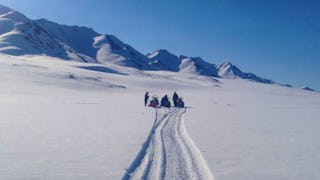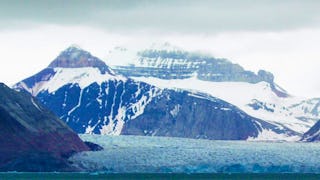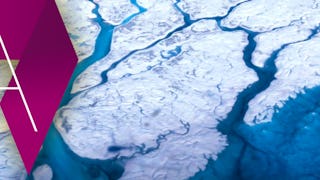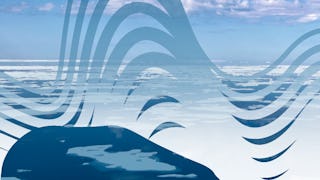This course takes a detailed look at the remarkable changes unfolding in the Arctic environment, including the shrinking Arctic sea ice cover, shrinking land ice, thawing permafrost and cascading impacts on Arctic ecosystems. After a review of Arctic climates of the past, attention turns to the possible future of the Arctic’s climate and environment.



Polar Peril
This course is part of Arctic Meltdown Specialization

Instructor: Mark C. Serreze
Included with 
(12 reviews)
What you'll learn
Identify the rapid environmental changes unfolding in the Arctic, the processes underlying these changes, and how they are related to each other
Evaluate and critique the evidence for past climate changes in the Arctic and projections of change through the 21 st century
Skills you'll gain
Details to know

Add to your LinkedIn profile
5 assignments
See how employees at top companies are mastering in-demand skills

Build your subject-matter expertise
- Learn new concepts from industry experts
- Gain a foundational understanding of a subject or tool
- Develop job-relevant skills with hands-on projects
- Earn a shareable career certificate


Earn a career certificate
Add this credential to your LinkedIn profile, resume, or CV
Share it on social media and in your performance review

There are 5 modules in this course
The Arctic is home to some of our planet's most visible indicators of climate change and we'll learn all about them in this module. Notable among these are the shrinking Arctic sea ice cover and the stronger warming of the Arctic compared to the rest of the globe, a phenomenon known as "Arctic Amplification". We'll then look at how the Arctic permafrost - perennially frozen ground - is warming and thawing. Finally, attention will turn to a direct threat to Arctic residents - coastal erosion and how it is tied to sea ice loss, ocean warming and warming permafrost.
What's included
5 videos1 assignment
The Arctic is home to the Greenland ice sheet, one of the planet's two ice sheets (the other is the Antarctic ice sheet) as well as many ice caps and glaciers. With few exception, these ice bodies are losing mass and contributing to sea level rise. Here we'll learn all about the Arctic's shrinking land ice, including the complexity of processes affecting the mass balance of the Greenland ice sheet, and the sad story of the disappearance of the two small ice caps that your instructor studied back in the early 1980s.
What's included
4 videos1 assignment
Here, we'll discover how changes in the Arctic are having cascading effects not just within the Arctic, but beyond the region. There is is evidence, albeit still controversial, that the strong warming of the Arctic, known as Arctic amplification, can influence weather patterns in middle latitudes. We'll see that the Arctic itself is experiencing extreme weather events. We'll also explore how treeless, windswept tundra is being taken over by shrubs, and how the loss of sea ice is is having impacts cascading through the marine food chain from phytoplankton to top predators like the polar bear.
What's included
4 videos1 assignment
A key part of understanding recent climate change in the Arctic, as well as where the Arctic may be headed, is to understand climates of the past - the realm of paleoclimatology. Here, we'll learn about the science of paleoclimatology, different types of paleoclimate data and some of the causes of past climate changes. The Arctic turns out to be a rich course of paleoclimate data. Then we'll focus on climates from the past million years up to the modern period, noting the tremendous changes that have occurred in the Arctic and elsewhere, setting the stage for a peek into the future.
What's included
4 videos1 assignment
This week, we'll first learn that while climate models are a key tools for making projections about the future Arctic, they also have biases and uncertainties. We'll then take a look at projected changes in temperature, precipitation and sea ice. We'll see that the Arctic is expected to continue to warm more strongly than the rest of the planet, that Arctic precipitation is likely to increase and that the sea ice cover will continue to shrink. However, it will also become clear that the magnitude of these changes will very much depend on human behavior - specifically, future rates of fossil fuel burning. Finally, we'll look at the permafrost carbon feedback, and its potential to lead to further warming of the planet.
What's included
4 videos1 assignment1 discussion prompt
Instructor

Offered by
Explore more from Environmental Science and Sustainability


University of Colorado Boulder


University of Colorado Boulder


École Polytechnique Fédérale de Lausanne


University of Alberta
Why people choose Coursera for their career




Learner reviews
12 reviews
- 5 stars
91.66%
- 4 stars
8.33%
- 3 stars
0%
- 2 stars
0%
- 1 star
0%
Showing 3 of 12
Reviewed on Dec 10, 2024
Excellent. Good selection of material. Well presented.
Reviewed on Mar 1, 2024
Great course. Everyone needs to be aware of what's happening.

Open new doors with Coursera Plus
Unlimited access to 10,000+ world-class courses, hands-on projects, and job-ready certificate programs - all included in your subscription
Advance your career with an online degree
Earn a degree from world-class universities - 100% online
Join over 3,400 global companies that choose Coursera for Business
Upskill your employees to excel in the digital economy
Frequently asked questions
Access to lectures and assignments depends on your type of enrollment. If you take a course in audit mode, you will be able to see most course materials for free. To access graded assignments and to earn a Certificate, you will need to purchase the Certificate experience, during or after your audit. If you don't see the audit option:
The course may not offer an audit option. You can try a Free Trial instead, or apply for Financial Aid.
The course may offer 'Full Course, No Certificate' instead. This option lets you see all course materials, submit required assessments, and get a final grade. This also means that you will not be able to purchase a Certificate experience.
When you enroll in the course, you get access to all of the courses in the Specialization, and you earn a certificate when you complete the work. Your electronic Certificate will be added to your Accomplishments page - from there, you can print your Certificate or add it to your LinkedIn profile. If you only want to read and view the course content, you can audit the course for free.
If you subscribed, you get a 7-day free trial during which you can cancel at no penalty. After that, we don’t give refunds, but you can cancel your subscription at any time. See our full refund policy.
More questions
Financial aid available,

